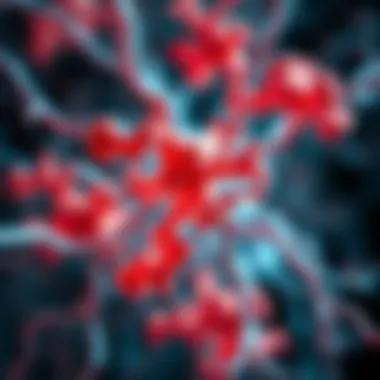The Protein Connection: Proteins and Pain Perception


Intro
Pain is a complex and often elusive phenomenon that can affect individuals in myriad ways. It isn't merely a sensation but, rather, a multifaceted experience influenced by numerous biological factors. One of the orchestral players in this grand symphony of pain perception is proteins. These tiny yet powerful molecules serve as the building blocks for various bodily functions, including the processing and transmission of pain signals. In the following sections, we will dive deep into the intricate relationship between proteins and pain, examining their roles in pain pathways, exploring the latest research findings, and uncovering potential strategies for pain management.
Research Overview
Summary of Key Findings
Research highlights a fascinating connection between specific proteins and the mechanisms of pain perception. Here are some findings worth noting:
- Substance P: This neuropeptide plays a crucial role in pain transmission, notably in the peripheral nervous system. Elevated levels are often associated with chronic pain conditions, leading to ongoing research into inhibitors that can dampen its effects.
- CGRP (Calcitonin Gene-Related Peptide): This protein has emerged as a critical player in migraine attacks. Recent studies have shown that targeting CGRP can offer relief for migraine sufferers through novel medications, demonstrating the potential of protein-based therapies in pain management.
- Inflammatory Cytokines: Proteins like IL-1 and TNF-alpha contribute to inflammatory responses that can result in increased pain sensitivity. Understanding the pathways these proteins influence offers a roadmap to designing more effective anti-inflammatory medications.
Background and Context
Pain, in its most fundamental sense, serves as a warning system—alerting the body to potential damage or ongoing injury. But when it becomes chronic, it often transforms into a condition that burdens those who suffer. According to research, over 20% of adults experience chronic pain, leading to a significant impact on quality of life and healthcare systems.
The interplay of proteins in pain responses is a burgeoning field of study, underpinned by advancements in molecular biology and neuroscience. By piecing together how proteins interact within pain pathways, scientists hope to unlock new avenues for intervention that could alleviate suffering.
Methodology
Experimental Design
Researchers adopt a heterogeneous array of experimental designs to explore the protein-pain connection:
- In Vitro Studies: Laboratory studies using isolated cells or tissues help identify direct interactions between proteins and pain receptors. This approach is invaluable in elucidating cellular responses to pain stimuli.
- Animal Models: Experimentation on rodent models mimics human pain conditions, aiding in assessing the role of specific proteins in vivo. By observing behavioral responses in these models, researchers gauge pain intensity and management effectiveness.
- Clinical Trials: Human studies are crucial for translating findings into practical treatments. Recent trials testing CGRP inhibitors have provided substantial insights into the efficacy of targeting proteins therapeutically.
Data Collection Techniques
Collecting significant data is essential to validate hypotheses and interventions. Here are notable techniques often employed:
- High-Throughput Screening: This technology allows researchers to evaluate numerous compounds quickly, identifying those that effectively bind to and inhibit pain-related proteins.
- Biomarker Analysis: Blood tests and tissue samples help quantify protein levels, establishing correlations between protein concentrations and pain severity.
- Neuroimaging: Technologies like fMRI and PET scans visualize brain activity in response to pain stimuli, shedding light on how proteins influence pain perception at a neurological level.
In summary, the emerging landscape of research indicates that the role of proteins in pain perception is both multifaceted and critical. Understanding these interactions will pave the way for innovative treatment methods aimed at improving the quality of life for individuals grappling with pain.
Prelims to Pain and Protein
Understanding the connection between proteins and pain is not just an academic exercise—it's a crucial investigation into how our bodies perceive and react to discomfort. This section aims to lay the groundwork for exploring the multifaceted role of proteins in pain mechanisms and offers insights that are pivotal for researchers, educators, and healthcare professionals alike.
In essence, pain isn't merely the body's alarm system; it's a complex interplay of biochemical signals that involves various proteins operating within intricate pathways. Interrogating these connections helps illuminate why certain individuals experience pain differently and informs potential therapeutic targets.
Through this exploration, we will consider how proteins contribute to pain messaging and modulation, paving the way for advancements in treatment strategies. The relevance of this topic stretches far beyond academic interest; implications for patient care, different modalities of pain management, and even preventive measures hinge on this critical understanding.
By diving into the mechanics of pain perception, we acknowledge the significance of proteins as both potential biomarkers and therapeutic targets. This discussion invites the reader to appreciate a nuanced view of pain—one that is informed by both biological science and clinical application.
Understanding Pain Mechanisms
Pain mechanisms are rather intricate, comprised of multiple layers of signaling between receptors and the nervous system. At its core, pain serves to protect the body from harm, alerting us to injury and stressors. The journey of pain signals begins when a stimulus—be it thermal, mechanical, or chemical—activates specific pain receptors known as nociceptors. These receptors are adept at sensing varied types of damages and convert these stimuli into electrical signals that travel along nerve fibers.
Furthermore, these signals are transmitted through the dorsal horn of the spinal cord and processed by various centers in the brain to produce the subjective experience we know as pain. This intricate communication ensures that every aspect of a potential threat is evaluated, leading to appropriate responses, such as withdrawal from danger. This is where proteins enter the stage; certain proteins not only facilitate this sensory transmission but also play regulatory roles in pain signaling pathways.
Role of Proteins in Human Physiology
The physiological landscape of the human body is fundamentally intertwined with proteins. Proteins encompass enzymes, structural elements, hormones, and more, each facilitating various functions essential for survival. In the context of pain, some proteins act as signaling molecules or receptors, while others assist in modulating the intensity and duration of pain experiences.


Key roles of proteins in pain physiology include:
- Receptor Activation: Certain proteins function as receptors that bind to pain-inducing substances, which triggers cascades of cellular activity.
- Signal Transduction: Proteins relay messages intracellularly, amplifying or dampening pain signals depending on the context.
- Repair Mechanisms: Proteins involved in cellular repair can influence inflammatory responses, which have a direct bearing on pain levels following injury.
By understanding the multi-layered roles that proteins play within this matrix, we can unlock deeper insights into how to tackle pain more effectively through research and innovative therapies.
"Recognizing the fundamental role of proteins in pain pathways opens new avenues for targeted treatment, offering hope where traditional methods may fall short."
Types of Proteins Involved in Pain
Understanding the diverse roles of proteins in the context of pain is crucial for grasping the complexities of pain perception and management. Proteins are not merely building blocks of our cells; they actively modulate various biological processes, including inflammation and nociception—the sensory process dealing with painful stimuli. In this section, we will delve into three distinct categories of proteins that play a pivotal role in pain: pain-sensing proteins, inflammatory proteins, and proteins involved in pain modulation. Each type of protein contributes uniquely to how pain manifests in the body, influencing therapeutic approaches aimed at alleviating pain.
Pain-Sensing Proteins
Pain-sensing proteins are essential components of the body's ability to detect harmful stimuli. They are primarily involved in transmitting pain signals from peripheral nerves to the central nervous system.
Transient Receptor Potential Channels
Transient Receptor Potential Channels, often abbreviated as TRP channels, are integral to the perception of pain. These proteins act as molecular sensors for various noxious stimuli, such as temperature changes, acidity, and mechanical strain. One of the key characteristics making TRP channels noteworthy is their ability to respond to both physical and chemical stimuli, which is critical in diverse pain conditions like neuropathic pain and inflammation.
- Advantages: The versatility of TRP channels in sensing multiple stimuli positions them as target points for developing pain relief strategies. For instance, they can be modulated to alleviate the heightened pain response often seen in chronic conditions.
- Disadvantages: However, excessive activation of TRP channels may contribute to allodynia, where non-painful stimuli are perceived painlessly, complicating the pain experience further.
Nociceptive Neuropeptides
Nociceptive neuropeptides are short chains of amino acids that play crucial roles in transmitting pain signals. These proteins are released by nociceptive sensory neurons and can modulate both peripheral and central aspects of pain. A key aspect of these neuropeptides, like Substance P and Calcitonin Gene-Related Peptide (CGRP), is their involvement in neurogenic inflammation, which can exacerbate pain levels.
- Advantages: Their ability to promote inflammation makes nociceptive neuropeptides important players in acute pain responses, potentially aiding the healing process.
- Disadvantages: On the flip side, their overproduction during chronic inflammatory states can lead to persistent pain, showcasing a dual role that poses challenges in pain management.
Inflammatory Proteins
Inflammatory proteins are crucial to the immune response, helping to regulate inflammation, which in turn affects pain perception. They can signal the presence of damage and initiate healing processes.
Cytokines
Cytokines are small proteins that play a vital role in cell signaling during immune responses. Many cytokines, such as interleukins and tumor necrosis factor (TNF), are released during inflammation and have been implicated in pain pathways. Their main characteristic as signaling molecules makes them central to understanding pain-related signaling and modulation.
- Advantages: Targeting specific cytokines offers promising avenues for reducing pain associated with inflammatory diseases like rheumatoid arthritis.
- Disadvantages: Due to their systemic effects, interfering with cytokine function can lead to unwanted side effects, creating a delicate balance in therapeutic approaches.
Chemokines
Chemokines are a specialized group of cytokines with a primary role in directing the movement of immune cells to sites of injury or inflammation. They help orchestrate immune responses and contribute to pain when inflammation occurs. One of their key characteristics is their ability to create gradients that immune cells follow, thus amplifying the pain response through increased cell infiltration at sites of injury.
- Advantages: Chemokines can serve as valuable biomarkers for assessing inflammatory conditions and pain states, aiding in timely intervention.
- Disadvantages: However, chronic chemokine signaling can lead to persistent pain conditions, complicating treatment options.
Proteins in Pain Modulation
Pain modulation occurs through proteins that either amplify or dampen pain signals, playing a significant role in how individuals experience and manage pain.
Opioid Peptides
Opioid peptides, such as endorphins and enkephalins, are naturally occurring substances in the body that interact with opioid receptors to relieve pain. One key characteristic of opioid peptides is their ability to block the transmission of pain signals at multiple levels, including the spinal cord and brain.
- Advantages: Their efficacy in pain relief makes them a cornerstone of both natural pain control and synthetic opioid development in medical practices.
- Disadvantages: However, the risk of addiction and adverse side effects poses significant challenges, urging a cautious approach to their use in pain management.


GABAergic Proteins
GABAergic proteins, particularly gamma-Aminobutyric acid (GABA), are crucial in inhibitory neurotransmission in the nervous system. These proteins help reduce neuronal excitability throughout the nervous system, playing a role in pain modulation.
- Advantages: By dampening excessive neuronal firing, they provide a protective mechanism against chronic pain conditions.
- Disadvantages: On the other hand, their role may not be enough in severe pain situations, highlighting the need for combination therapies that can provide more comprehensive relief.
Understanding the intricate roles of these proteins can inform future research and clinical practices, potentially leading to innovative approaches in pain management.
Molecular Pathways Linking Proteins and Pain
Understanding the molecular pathways that connect proteins to pain is pivotal in grasping how our bodies respond to various forms of discomfort. In recent years, researchers have made significant strides in elucidating these pathways, revealing the intricate relationship between proteins and the processes that lead to pain perception. Analyzing these connections not only enhances our basic understanding of pain mechanics but also opens the door to innovative therapeutic approaches.
The pathways themselves act as conduits, transmitting signals from the site of injury or inflammation to the central nervous system. This communication is often mediated by proteins that play roles in sensory detection and signaling, such as those found in nerve endings and within the spinal cord.
With this in mind, comprehending the nuances of these molecular interactions can bolster pain management strategies.
- Significance of Protein Interactions: Proteins serve as regulators of pain intensity and duration. These interactions can dictate how pain is perceived and processed.
- Applications in Therapy: By targeting specific proteins or pathways, it’s feasible to develop tailored pain relief options that could reduce dependency on conventional medications.
In essence, a deep dive into the molecular labyrinth connecting proteins and pain reveals valuable insights that can reshape how we approach therapy. Let’s further explore some key components of this connection.
Central Sensitization Mechanisms
Central sensitization is the phenomenon whereby the central nervous system becomes more sensitive to stimuli following an injury. Here, pain pathways are not merely reactive; they undergo a transformation that intensifies the perception of pain over time. This mechanism is critical to understanding conditions such as fibromyalgia and chronic pain syndromes.
At play are several proteins involved in this greater sensitivity:
- Neurotransmitters like glutamate amplify signals in the pain pathways.
- Receptors such as NMDA (N-Methyl-D-Aspartate) can become overactive in the context of persistent pain, further perpetuating this sensitization.
Furthermore, central sensitization can lead to a state of hyperalgesia, where painful stimuli evoke extreme responses. Understanding these mechanisms is vital for developing effective treatments and interventions to manage chronic pain more effectively.
Peripheral Sensitization and Inflammation
On the other side of the equation lies peripheral sensitization, where pain receptors in the tissues become more reactive due to inflammation. In various instances, inflammation acts as the catalyst for peripheral sensitization.
Certain proteins in the inflammatory process play a significant role:
- Cytokines, such as TNF-alpha and interleukins, are released during injury. These proteins can prime nociceptors, making them more responsive to pain signals.
- Chemokines help in recruiting other immune cells to the site of inflammation, sustaining the sensitization process and exacerbating pain.
The dual interaction between inflammation and pain provides a framework through which scientists can explore new therapeutic avenues. By focusing on interrupting these pathways, there is potential not only to ease pain but also to address its underlying causes.
"Exploring molecular pathways is akin to tracing the steps of a crime. Each protein holds a clue to understanding the larger picture of pain perception."
By delving into these areas, researchers can gather insights that enable the development of targeted treatments, ultimately leading to more efficient pain management solutions. The implications of these pathways extend beyond merely alleviating symptoms; they invite a holistic approach to understanding and treating pain in ways that resonate deeply with the physiological realities of human experience.
For more extensive insights on pain and proteins, visit NIH or review articles on PubMed. Whether for academic purposes or personal understanding, these resources offer a wealth of information that can deepen one’s grasp of this complex interplay.
Research Advances in Pain and Proteins
In recent years, the understanding of how proteins influence pain perception has grown leaps and bounds. This advancement couldn’t have come at a better time, as the quest for more effective pain management strategies becomes increasingly critical. The urgency stems, in part, from the rising opioid crisis and the need for alternative therapies that target the underlying mechanisms of pain rather than merely masking its symptoms. By investigating the connections between specific proteins and pain pathways, researchers are carving out new paths in both research and practical applications for pain management.
Current Studies on Pain-Related Proteins
Today, scientists are delving into the roles various proteins play in pain signaling. A substantial focus is on proteomic analysis, which examines the expression of proteins in different types of tissues during pain states. Research has highlighted how certain proteins, particularly receptors and enzymes, are significantly involved in the transmission of pain signals to the nervous system. For instance, studies have shown that the calcitonin gene-related peptide (CGRP) is a critical player in migraine disorders, providing insight into preventive therapies that can block its pathway.


Moreover, the exploration of nociceptive pathways has yielded practical findings, revealing how specific proteins interact with pain receptors, such as the transient receptor potential (TRP) channels. These interactions contribute to the body’s perception of painful stimuli, offering a target for interventions which can potentially alleviate chronic pain conditions.
Advancements in Pain Management
The leap in our knowledge around proteins related to pain has led to remarkable advancements in therapeutic strategies.
Targeting Proinflammatory Proteins
Targeting proinflammatory proteins, such as cytokines and chemokines, represents a promising strategy. These proteins are often elevated in chronic pain states and are major contributors to inflammation and pain sensitivity. By inhibiting their activity, researchers are hopeful in disrupting the cycle of pain and inflammation.
Key characteristics of this approach include the development of monoclonal antibodies that specifically target interleukin-6 (IL-6) or tumor necrosis factor-alpha (TNF-alpha), two well-known proinflammatory proteins associated with various pain syndromes. The advantages of targeting these proteins include a more focused area of intervention that can lead to less systemic side effects compared to conventional pain medications. However, there remains a downside: the complexity of inflammatory pathways can make it challenging to predict outcomes from targeting these singular proteins, necessitating further research.
Novel Therapeutics
Novel therapeutics are emerging as a beacon of hope for those suffering from pain. This category includes the development of small molecule inhibitors that can act on specific pathways implicated in pain. For instance, advancements in pharmacological agents that target the TRP channels are showing promise in clinical trials.
The appeal lies in their ability to offer pain relief without the side effects commonly seen in opioids. Unique features of these treatments often include the potential for oral administration, making them far more accessible for patients who need consistent management of their pain.
Nevertheless, the road ahead is not without challenges. There is variability in patient response, which makes personalization of treatment a critical component of future developments. Research efforts continue to refine these therapeutics, highlighting the importance of tailoring therapies to individual protein responses in pain so that patients can find effective relief.
"Understanding how proteins interact with various pain pathways is not just academic; it’s a gateway to improving the quality of life for countless individuals suffering from chronic pain."
For more in-depth reading, check resources like Wikipedia, and Britannica for further exploration of pain mechanisms and management.
Implications for Pain Therapy
Understanding how proteins relate to pain is becoming crucial in designing effective therapy. With the rise of personalized medicine, it brings potential to tailor pain management strategies based on individual protein profiles. The influence of proteins on pain pathways can't be overstated; they serve as both indicators and targets in managing pain.
Protein Biomarkers for Pain Assessment
The concept of protein biomarkers is an exciting frontier in pain research. Biomarkers are measurable indicators of a biological condition, and in this context, certain proteins can signal the presence or severity of pain. For instance, elevated levels of C-reactive protein can indicate inflammation, which may correlate with chronic pain conditions.
Using protein biomarkers for assessing pain has several benefits:
- Objective Measurement: Biomarkers provide a quantifiable means of evaluating pain, moving beyond patient self-reports which can be subjective and inconsistent.
- Early Detection: The presence of certain proteins before pain onset may help in identifying individuals at risk of chronic pain, such as those with arthritis or fibromyalgia.
- Monitoring Treatment Response: By measuring protein levels during treatment, healthcare providers can assess how well therapy is working, adjusting it accordingly to improve patient outcomes.
However, there's a caveat. The specificity of these biomarkers needs to be thoroughly evaluated. Not all proteins may specifically indicate pain, as they can also be elevated during other physiological responses, like infections. Ongoing research is vital to demarcate the precise roles proteins play in pain perception.
Personalized Medicine Approaches
Personalized medicine stands at the crossroads of genetics, data analytics, and biochemistry. By analyzing an individual’s protein makeup, healthcare providers can tailor pain therapies to suit each person’s unique profile. This means no cookie-cutter prescriptions, just carefully crafted solutions based on empirical evidence.
- Genetic Insights: Understanding a patient’s genetic predisposition to certain proteins can shape therapeutic choices. For some, opioids may be effective, while for others, alternative treatments could yield better results.
- Custom Protocols: Some patients may respond well to specific biochemical agents while others do not. Personalized approaches allow for customized treatment regimens that may include biologics, targeted therapies, or even lifestyle changes that modulate protein expression.
- Patient Engagement: This approach also empowers patients. With clear insights into how their proteins affect pain, people can become more active participants in their own healthcare decisions, leading to better adherence to treatment plans.
As science progresses, the integration of protein analysis into clinical routines could revolutionize pain management, shifting focus to understanding and targeting the biological underpinnings of pain, rather than just treating its symptoms.
Culmination
In wrapping up the exploration of the intricate relationship between proteins and pain, it's essential to reflect on the complexity and the implications on human health that this connection holds. The insights gathered from the preceding sections reveal not just the biological underpinnings but also the significant therapeutic avenues that emerge from understanding these mechanisms.
First and foremost, recognizing the role of proteins in pain sensation and modulation sets a foundation for more targeted therapies. For instance, by identifying specific pain-sensing proteins and inflammatory markers, researchers can develop novel pain management strategies that are less reliant on opioids. This is particularly crucial given the ongoing crisis surrounding opioid addiction; alternative treatments can potentially alleviate suffering without the risks associated with traditional pain management practices.
Moreover, the emerging concept of personalized medicine prominently features in our conclusion. By assessing protein biomarkers unique to individual pain profiles, healthcare providers can tailor their approaches, improving outcomes and minimizing side effects. This adaptability is a game-changer in pain management, making it more effective and patient-centric.
It's also worth noting the ongoing research that promises to redefine our understanding of pain. Emerging studies continue to uncover new proteins and pathways, further enriching the dialogue in both scientific and clinical communities. The implications for education, practice, and future research are vast. As we uncover more about how specific proteins influence pain responses, we continue to lay the groundwork for innovations that can dramatically shift how pain is treated.
"Knowledge is not power; it is only potential power. It becomes power only when, and if, it is organized into a definite plan of action." – Napoleon Hill
In summary, the exploration of proteins in the context of pain reinforces a pivotal truth: understanding the biology underlying pain not only illuminates the mechanisms driving it but also enables the development of more effective, innovative solutions to treat it. The path ahead is compelling, and as we continue to unravel the complexities involved, the benefits could reshape the landscape of pain therapy for years to come.







